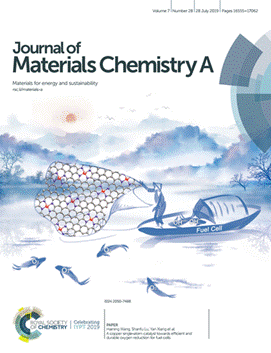| A copper single-atom catalyst towards efficient and durable oxygen reduction for fuel cells |
| From: PublishDate:2020-07-30 Hits: |
Cathodic oxygen reduction reaction (ORR) kinetics is relatively slow, and it relies heavily on precious metal Pt catalysts, which has become an important factor restricting the large-scale application of fuel cells. Therefore, the development of non-Pt catalysts is urgent for the practical applications of PEMFCs. Transition metal single-atom catalysts (SAC) have demonstrated excellent ORR performance in single-electrode characterization, and have attracted great attention in recent years. In previous research reports, the transition metals are mostly Fe, Co, Ni, etc. Even though Cu is nature's choice for ORR catalysis in many forms of life from bacteria to humans; however, only a few studies of Cu-based SACs for the ORR have been reported. Furthermore, the applications of Cu SACs for fuel cells have rarely been demonstrated. The research group of Professor Yan Xiang from Beihang University successfully prepared a single-atom copper catalyst for the oxygen reduction reaction of the fuel cell cathode. This study is published in Journal of Materials Chemistry A entitled as "A copper single-atom catalyst towards efficient and durable oxygen reduction for fuel cells" as a front cover paper.
In this study, we prepared a Cu SAC using Cu phthalocyanine (CuPc) as the precursor through a simple pyrolysis method. Spherical aberration electron microscopy (HAADF-STEM) showed uniform dispersion of monoatomic Cu. At the same time, XAFS experiment carried out at 1W1B-XAFS station of Beijing Synchrotron Radiation Facility (BSRF) confirmed the successful preparation of Cu SAC and further analysis of its structure. The electrochemical test results showed that the catalyst showed good ORR performance in alkaline medium, and its half-wave potential was 0.81 V (vs. RHE), 30 mV lower than that of commercial Pt/C. At the same time, it shows excellent durability. After 5000 cycles in the alkaline medium, the half wave potential only has a negative shift of 9 mV. An anion exchange membrane fuel cell based on the Cu SAC exhibits a peak power density of 196 mW cm-2 at 70 ℃. The DFT calculation suggests that the transformation process from OOH* to O* is the rate determining step of the ORR on the Cu SAC. The Cu SAC could be a promising non-noble ORR catalyst for fuel cell applications.
Figure 1 (a) Morphology of Cu SAC characterized by spherical aberration correction electron microscopy. (b) EXAFS characterization of Cu SAC and Cu foil. (c) Theoretical calculation model for Cu SAC adsorption of oxygen. (d) Durability test of Cu SAC. (e) Polarization curve of an anion exchange membrane fuel cell using Cu SAC as a cathode catalyst. (f) The ORR reaction path of Cu SAC and Pt (111) calculated by density functional theory.
Article: Cui, L. T.; Cui, L. R.; Li, Z. J.; Zhang, J.; Wang, H. N.; Lu, S. F.; Xiang, Y., A copper single-atom catalyst towards efficient and durable oxygen reduction for fuel cells. J. Mater. Chem. A 2019, 7, 16690-16695. |
|
|
| Chinese
- Metal-free efficient photocatalyst for stable visible water splitting——Top ten major scientific progresses in China in 2015
- The nano-resolution imaging platform was awarded the first rate prize of Beijing Science and Technology in 2014
- Beamline 1W1 of BSRF started to runoperate in the couplingparasitic mode of BEPCII
- Synthesis of High Performance Polymer Materials for Field Effect-Transistors
- Surfactant molecular aggregates in green solvents
- GIXRD has played an important role in the characterization of organic thin-film transistors
Science Highlights
Home /
Copyright © 2011 - 2012 Beijing Synchrotron Radiation Facility



